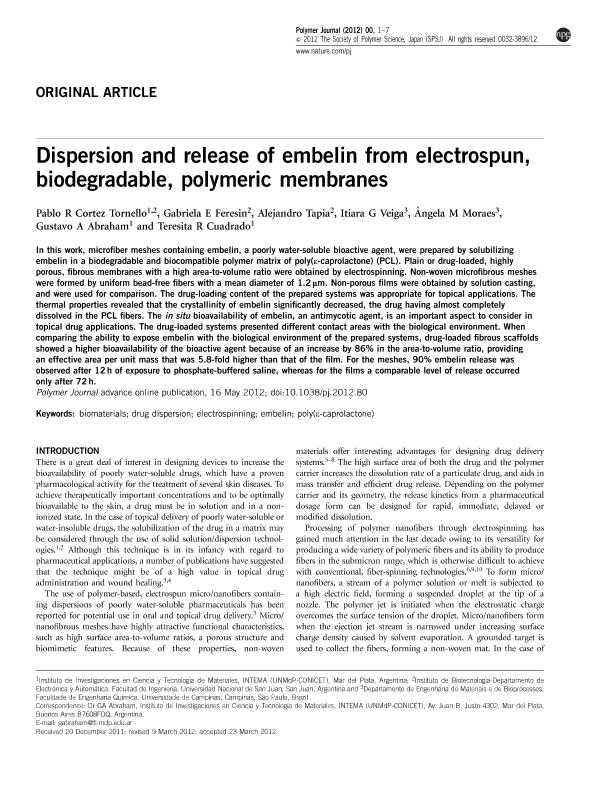Mostrar el registro sencillo del ítem
dc.contributor.author
Cortez Tornello, Pablo Roberto

dc.contributor.author
Feresin, Gabriela Egly

dc.contributor.author
Tapia, Alejandro
dc.contributor.author
Veiga, Itiara G.
dc.contributor.author
Moraes, Ângela M.
dc.contributor.author
Abraham, Gustavo Abel

dc.contributor.author
Cuadrado, Teresita Raquel

dc.date.available
2016-06-24T17:46:40Z
dc.date.issued
2012-05-16
dc.identifier.citation
Cortez Tornello, Pablo Roberto; Feresin, Gabriela Egly; Tapia, Alejandro; Veiga, Itiara G.; Moraes, Ângela M.; et al.; Dispersion and release of embelin from electrospun biodegradable, polymeric, membranes; Nature Publishing Group; Polymer Journal; 44; 16-5-2012; 1105-1111
dc.identifier.issn
0032-3896
dc.identifier.uri
http://hdl.handle.net/11336/6247
dc.description.abstract
In this work, microfiber meshes containing embelin, a poorly water-soluble bioactive agent, were prepared by solubilizing embelin in a biodegradable and biocompatible polymer matrix of poly(ε-caprolactone) (PCL). Plain or drug-loaded, highly porous, fibrous membranes with a high area-to-volume ratio were obtained by electrospinning. Non-woven microfibrous meshes were formed by uniform bead-free fibers with a mean diameter of 1.2 μm. Non-porous films were obtained by solution casting, and were used for comparison. The drug-loading content of the prepared systems was appropriate for topical applications. The thermal properties revealed that the crystallinity of embelin significantly decreased, the drug having almost completely dissolved in the PCL fibers. The in situ bioavailability of embelin, an antimycotic agent, is an important aspect to consider in topical drug applications. The drug-loaded systems presented different contact areas with the biological environment. When comparing the ability to expose embelin with the biological environment of the prepared systems, drug-loaded fibrous scaffolds showed a higher bioavailability of the bioactive agent because of an increase by 86% in the area-to-volume ratio, providing an effective area per unit mass that was 5.8-fold higher than that of the film. For the meshes, 90% embelin release was observed after 12h of exposure to phosphate-buffered saline, whereas for the films a comparable level of release occurred only after 72h.
dc.format
application/pdf
dc.language.iso
eng
dc.publisher
Nature Publishing Group

dc.rights
info:eu-repo/semantics/openAccess
dc.rights.uri
https://creativecommons.org/licenses/by-nc-sa/2.5/ar/
dc.subject
Biomaterials
dc.subject
Drug Dispersion
dc.subject
Electrospinning
dc.subject
Embelin
dc.subject
Poly(E-Caprolactone)
dc.subject.classification
Físico-Química, Ciencia de los Polímeros, Electroquímica

dc.subject.classification
Ciencias Químicas

dc.subject.classification
CIENCIAS NATURALES Y EXACTAS

dc.subject.classification
Bioproductos, Biomateriales, Bioplásticos, Biocombustibles, Bioderivados, etc.

dc.subject.classification
Biotecnología Industrial

dc.subject.classification
INGENIERÍAS Y TECNOLOGÍAS

dc.title
Dispersion and release of embelin from electrospun biodegradable, polymeric, membranes
dc.type
info:eu-repo/semantics/article
dc.type
info:ar-repo/semantics/artículo
dc.type
info:eu-repo/semantics/publishedVersion
dc.date.updated
2016-06-08T17:51:57Z
dc.journal.volume
44
dc.journal.pagination
1105-1111
dc.journal.pais
Japón

dc.journal.ciudad
Tokio
dc.description.fil
Fil: Cortez Tornello, Pablo Roberto. Consejo Nacional de Investigaciones Científicas y Técnicas. Centro Científico Tecnológico Mar del Plata. Instituto de Investigación En Ciencia y Tecnología de Materiales (i); Argentina. Universidad Nacional de San Juan. Facultad de Ingeniería. Instituto de Biotecnología; Argentina
dc.description.fil
Fil: Feresin, Gabriela Egly. Universidad Nacional de San Juan. Facultad de Ingeniería. Instituto de Biotecnología; Argentina
dc.description.fil
Fil: Tapia, Alejandro. Universidad Nacional de San Juan. Facultad de Ingeniería. Instituto de Biotecnología; Argentina
dc.description.fil
Fil: Veiga, Itiara G.. Universidade Estadual de Campinas; Brasil
dc.description.fil
Fil: Moraes, Ângela M.. Universidade Estadual de Campinas; Brasil
dc.description.fil
Fil: Abraham, Gustavo Abel. Consejo Nacional de Investigaciones Científicas y Técnicas. Centro Científico Tecnológico Mar del Plata. Instituto de Investigación En Ciencia y Tecnología de Materiales (i); Argentina. Universidad Nacional de Mar del Plata. Facultad de Ingeniería; Argentina
dc.description.fil
Fil: Cuadrado, Teresita Raquel. Consejo Nacional de Investigaciones Científicas y Técnicas. Centro Científico Tecnológico Mar del Plata. Instituto de Investigación En Ciencia y Tecnología de Materiales (i); Argentina. Universidad Nacional de Mar del Plata. Facultad de Ingeniería; Argentina
dc.journal.title
Polymer Journal

dc.relation.alternativeid
info:eu-repo/semantics/altIdentifier/doi/10.1038/pj.2012.80
dc.relation.alternativeid
info:eu-repo/semantics/altIdentifier/doi/http://dx.doi.org/10.1038/pj.2012.80
dc.relation.alternativeid
info:eu-repo/semantics/altIdentifier/url/http://www.nature.com/pj/journal/v44/n11/full/pj201280a.html
Archivos asociados
